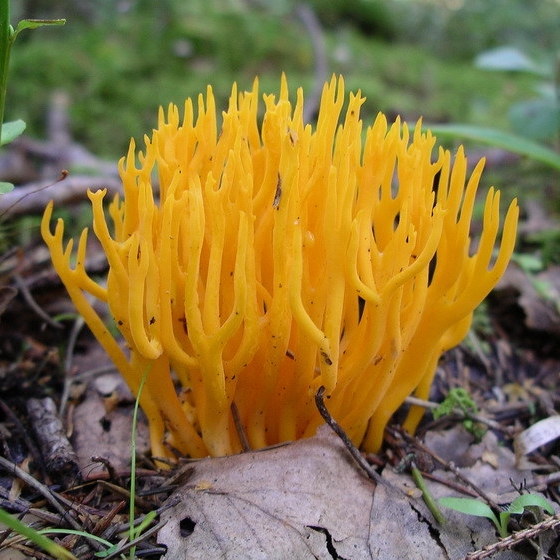
It’s easy to see how this fungus got its name. It is most commonly seen from summer to autumn.
Photo: Nomeda Vėlavičienė, CC BY-SA 3.0, via Wikimedia Commons
Scientific name: Calocera viscosa
Other common names: Jelly Antler
What to look for:
- Appearance : Yellow-orange gelatinous branching body, usually up to 8 cm tall, shaped like antlers, greasy in texture somewhat slimy when wet. Found in groups. When dry, the colour may deepen to a more red-orange.
- Spores : Elongated. White spore print.
- Where : On rotting conifer wood and debris in Britain, mainland Europe.
- When : Summer to autumn.
- Similar species : Others in the Calocera genus, including Small Stagshorn (Calocera cornea), the fruiting body of which is less than 1 cm tall, and generally unbranched, and which is found on broadleaf (mainly Beech) trees.
Yellow Stagshorn is a widespread and common fungus, but no less impressive for that, with its bright orange-yellow colour and branching fruiting body. It grows on rotting conifer wood and stumps. If it looks like it’s growing from the soil, this is probably because the tree stump has been buried by leaf and other debris. Mainly found in the late summer to autumn, it can however fruit at other times of the year. Look out for it in winter, when its yellow ‘antlers’ stand out against the stark, dark background.
Did you know…?
…The genus name Calocera translates as ‘beautiful and waxy’, while the species name viscosa means ‘sticky’.
…Not known to be poisonous, the lack of flavour and gelatinous texture nonetheless mean this fungus is considered inedible.

More information and references:
Buczacki, S., Shields, C., Ovenden, D., 2012. Collins Fungi Guide. Collins, London.
Published: January 2015
Author: Amanda Scott
Photos: Nomeda Vėlavičienė, CC BY-SA 3.0, via Wikimedia Commons
